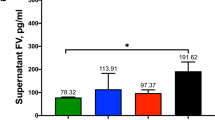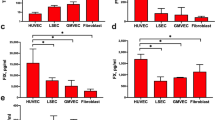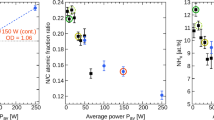Abstract
THROMBIN, a serine protease with great specificity, is a potent mitogen for resting chick embryo fibroblasts in culture1–3. So far only a limited number of peptide bonds in a few native proteins have been found to be sensitive to proteolysis by thrombin, namely four Arg–Gly bonds in fibrinogen4 and a few arginyl and lysyl bonds in actin5. It is likely therefore that the number of fibroblast surface proteins susceptible to this protease will also be limited, whereas with trypsin many surface proteins are attacked. Thus thrombin may be an excellent probe for studies of the role of changes in cell surface composition during mitogenesis or cell-cell interaction. A large, external transformation sensitive (LETS) protein6–10, postulated10,11 to be involved in cellular growth control, is insensitive to thrombin2. This observation led to the conclusion that the removal of LETS is not a necessary condition for cell growth when a protease is used to stimulate growth.
This is a preview of subscription content, access via your institution
Access options
Subscribe to this journal
Receive 51 print issues and online access
$199.00 per year
only $3.90 per issue
Buy this article
- Purchase on Springer Link
- Instant access to full article PDF
Prices may be subject to local taxes which are calculated during checkout
Similar content being viewed by others
References
Chen, L. B., and Buchanan, J. M., Proc. natn. Acad. Sci. U.S.A., 72, 131–135 (1975).
Teng, N. N. H., and Chen, L. B., Proc. natn. Acad. Sci. U.S.A., 72, 413–417 (1975).
Chen, L. B., Teng, N. N. H., and Buchanan, J. M., Proteases and Biological Control, (edit. by Reich, E. Rifkin, D., and Shaw, E.), 957–965 (Cold Spring Harbor Laboratory, New York, 1975).
Magnusson, S., The Enzymes, (edit. by Boyer, P. D.), 3, 277–321 (Academic, New York, 1971).
Muszbek, L., and Laki, K., Proc. natn. Acad. Sci. U.S.A., 71, 2208–2211 (1974).
Hynes, R. O., Proc. natn. Acad. Sci. U.S.A., 70, 3170–3174 (1973).
Hogg, N. M., Proc. natn. Acad. Sci. U.S.A., 71, 489–492 (1974).
Wickus, G. G., Branton, P. E., and Robbins, P. W., Control of Proliferation in Animal Cells (edit. by Clarkson, B. and Baserga, R.), 541–546 (Cold Spring Harbor Laboratory, New York, 1974).
Stone, K. R., Smith, R. E., and Joklik, W. K., Virology, 58, 86–100 (1974).
Hynes, R. O., Cell, 1, 147–156 (1974).
Blumberg, P. M., and Robbins, P. W., Proteases and Biological Control (edit. by Reich, E. Rifkin, D. and Shaw, E.), 945–956 (Cold Spring Harbor Laboratory, New York, 1975).
Author information
Authors and Affiliations
Rights and permissions
About this article
Cite this article
TENG, N., BO CHEN, L. Thrombin-sensitive surface protein of cultured chick embryo cells. Nature 259, 578–580 (1976). https://doi.org/10.1038/259578a0
Received:
Accepted:
Issue Date:
DOI: https://doi.org/10.1038/259578a0
This article is cited by
-
Thrombin-stimulated cell division involves proteolysis of its cell surface receptor
Nature (1979)
-
Factors involved in the modulation of cell proliferation in vivo and in vitro: The role of fibroblast and epidermal growth factors in the proliferative response of mammalian cells
In Vitro (1978)
-
Initiation of chick cell division by trypsin action at the cell surface
Nature (1977)
-
Local inhibition of centripetal particle transport where LETS protein patterns appear on 3T3 cells
Nature (1977)
Comments
By submitting a comment you agree to abide by our Terms and Community Guidelines. If you find something abusive or that does not comply with our terms or guidelines please flag it as inappropriate.



